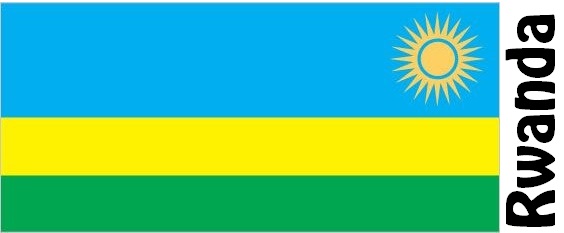Flags of Countries that Start with R
How many countries beginning with R? There are a total of 4 countries starting with letter R among the 193 countries in the world:
- Republic of the Congo
- Romania
- Russia
- Rwanda
Romania

Romania is a republic in southern Europe. The country is located in the northeastern Balkans with borders to Bulgaria, Serbia, Hungary, Ukraine and Moldova and coast to the Black Sea. The central part of Romania is dominated by the Carpathian Mountains, platters and plateaus. In the island and S the landscape consists mostly of lowland and river plains.
There is a temperate mainland climate with large temperature fluctuations.
The country’s most important natural resources are oil, coal, iron and other minerals as well as natural gas, timber and agricultural land. Agriculture employs approx. 1/3 of the workforce. The main crops are maize, wheat and potatoes.
Romania was communist in the period 1947-1989. The country was joined as a member of NATO in 2004 and in the EU in 2007.
Country Facts – State Capital – Population Graph – Airports – Public Holidays – Embassies of Romania – Embassies in Romania – Import Regulations – Major Trade Partners – Major Imports – Major Exports
Russia

Russia is a republic that constitutes a large part of Eastern Europe as well as the northern and central parts of Asia. Russia borders 14 countries and has coastlines to the northern part of the Arctic and Pacific. IV, the landscape consists of plains separated from the eastern part of the Ural Mountains. On the island of the Ural Mountains lies Siberia with lowlands, plateaus and low mountains. IS and Island consist of highlands with mountain ranges and active volcanoes. There are many large rivers in Russia.
The climate is mostly temperate mainland climate, but varies widely. There is dry steppe climate in S, more humid climate in V, polar climate and tundra in N.
Russia is rich in natural resources. a. Natural gas, oil, coal, minerals, wood and fish.
From 1917 to 1991, Russia constituted the largest part of the Soviet Union. Russia annexed the Ukrainian peninsula of Crimea in 2014, which has created an international crisis.
Country Facts – State Capital – Population Graph – Airports – Public Holidays – Embassies of Russia – Embassies in Russia – Import Regulations – Major Trade Partners – Major Imports – Major Exports
Republic of the Congo

Congo (Republic) is a republic in western Central Africa. The country faces the Atlantic Ocean. The central parts consist of a low plateau and swampy river valleys. The area along the Congo River is especially swamp and rainforest surrounded by ridge and mountain ranges with savanna. There is a wide coastal plain in SV.
The climate is tropical with a short dry season in June-August.
The extraction and export of oil is fundamental to the country’s economy. Timber is also a very large export product. Agriculture employs the majority of the working population.
Formerly the Congo (Republic) was a French colony, under the name French Congo. Independence in 1960.
Country Facts – State Capital – Population Graph – Airports – Embassies of Republic of the Congo – Embassies in Republic of the Congo – Major Imports – Major Exports
Rwanda

Rwanda is a republic in East Africa. The country is located in the western part of the Rift Valley and borders on Congo (Democratic), Uganda, Tanzania and Burundi. The landscape consists of plateaus, mountains and volcanoes as well as the low-lying Kivusøø in V.
The climate is tropical and fertile with some rainfall spread over two rainy seasons.
Agriculture is Rwanda’s most important profession. In particular, crops are grown for self-sufficiency and coffee for export. Some years there is a great lack of food.
Rwanda is Africa’s most densely populated country. The country is very poor and dependent on foreign aid. Rwanda has previously been plagued by civil war and violent clashes between the majority of Hutus and the minority of Tutsis. Former German and then Belgian colony until 1962.

Country Facts – State Capital – Population Graph – Airports – Public Holidays – Embassies of Rwanda – Import Regulations – Major Trade Partners – Major Imports – Major Exports













































